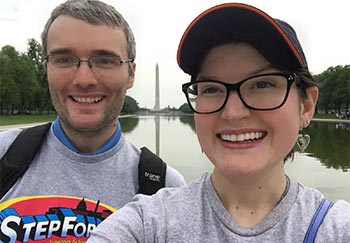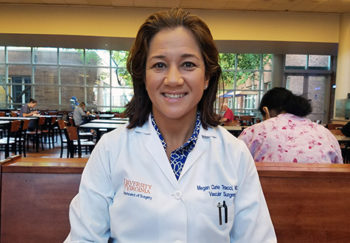
Derek Bauer, MD, contributed this post. Bauer is a UVA neurologist who treats epilepsy and tuberous sclerosis.
I was diagnosed with tuberous sclerosis (TSC) when I was 12, and it was only because of my determined mom.
What Is Tuberous Sclerosis?
TSC is a neurocutaneous syndrome, resulting from a genetic abnormality that causes cells throughout the body to form improperly. In a nutshell, TSC is a disease that can cause tumors anywhere in the body, head-to-toe. They aren’t considered cancerous and typically grow very slowly.
The National Organization for Rare Disorders includes TSC as a rare disease, with a prevalence around 1 in 6,000 people.
About 85 percent of TSC patients have epilepsy, and about half of TSC patients have some amount of cognitive impairment. I don’t have either, although I had seizures as an infant.
Given those numbers, you can probably see why my story isn’t typical.
Struggling to be Heard: My Rare Disease Diagnosis and Care
My doctor diagnosed me because of angiofibroma, a type of rash on my face. Until I was 12, I mistook the bumps for freckles. It became clear they weren’t the first few times I tried to shave and they bled, because they’re actually small tumors that are full of blood vessels.
I went through multiple providers before my mom took me to a dermatologist who made the connection to TSC. She also found a few small hypopigmented (white) spots on my legs, which are typical of TSC. She ordered an MRI, and that’s how she found the tubers on my brain. You can think of tubers as a grouping of disorganized cells that are often hardened or calcified. That’s actually how TSC gets its name.
I became a physician because of my experience with my TSC diagnosis and initial management. I never felt like the physicians understood me or my disease. Upon multiple occasions, providers told me, “There’s nothing more we can do, and you’re so mildly affected, you should go out and live life.”
We now know that’s not the case. Non-brain manifestations of TSC usually come later than the teenage years. They include:
- Angiomyolipomas (growths on the kidneys)
- Lymphangiomyomatosis (or LAM for short which are a lung manifestation of TSC)
- Very rare tumors can occur that involve the liver and pancreas
TSC Alliance guidelines recommend intermittent lifetime surveillance for these manifestations. I became a physician because I didn’t want others to have the same experience I did.
Living With TSC
Being a patient and a physician puts me in a unique position. It helps me understand the demands of chronic disease, which can creep up in surprising ways. Sure, there’s always the nuts and bolts aspect of it — the demands on time, going to tests and appointments.
Researching TSC?
The Tuberous Sclerosis Alliance recognized our clinic for its collaborative approach. Learn more about TSC treatment at UVA.
However, what continues to surprise me the most is how TSC can find me when I least expect. The best example I can give is with my running, a huge source of fun and stress relief for me. Last summer I pushed myself to run a 7-minute mile. When I finally accomplished this goal and finished my run, I felt awesome — until I took my shoes off. You see, my right foot was covered in blood, so much that it bled through my sock into my shoe. TSC is associated with nailbed tumors called ungal fibromas. They have a tendency to bleed when irritated and I had really irritated mine.
I think that’s what I’ve learned the most about TSC and having a chronic disease in general, I suppose. It’s there on good days and bad, it’s there when you’re busy and don’t have time to think about it and it’s still there when you have quiet time and can. It never leaves you.
Knowing that I’m dealing with a disease I was born with and will die with continually leaves me with a sinking feeling. In my case, I can’t say it’s a fight or a struggle, as my case is so mild in comparison to so many others. However, I think my role is to help those for which this disease is truly a fight, day in and day out, for basic quality of life and, for some, even survival.


Hi Derek, it was really great to heard this. I am about the same than you. However I do not work in the medical field. I’d like to know how could I help, either by donating or volunteering. Also, which are the responsible steps I should take to keep track and monitor my situation. I have to say that I struggle to find experts in Spain / France that can follow my evolution and advise me. Thank you so much!
My nephew was just diagnosed with TSC today. I researched and learned about it. My mom called me because my nephew wanted to tell me something. Upon answering the video call, he excitedly told me “my doctor was so nice, she did not give me a shot”. I bursted into tears but managed to pretend everything is okay. My nephew even told me that i have to repay him “play time” for being brave to see a doctor. He is the most precious person in our family.
Doctor,
Your story is uplifting. I am a late bloomer physician getting ready for my Step 3.
Blessings from Puerto Rico.
Hi I am Deborah.. mother of five children !
My husband recently passed away! He had TSC; Diagnosed and died of Louis body dementia; however, my five children are affected by this disease! I now have seven grand children and some family members I have seizures, the bumps on their noses, Rap of myomas in their hearts, I would love to be a resource and a help for families!
I enjoyed this article! I am also a mildly affected adult (probably mosaic) with TSC. I did not know I had TSC until I was 26 years old and went to NIH for a LAM study and got a brain MRI…and there was one tuber. Paired with kidneys, LAM, and facial angios, we have a diagnosis! We are the lucky ones!